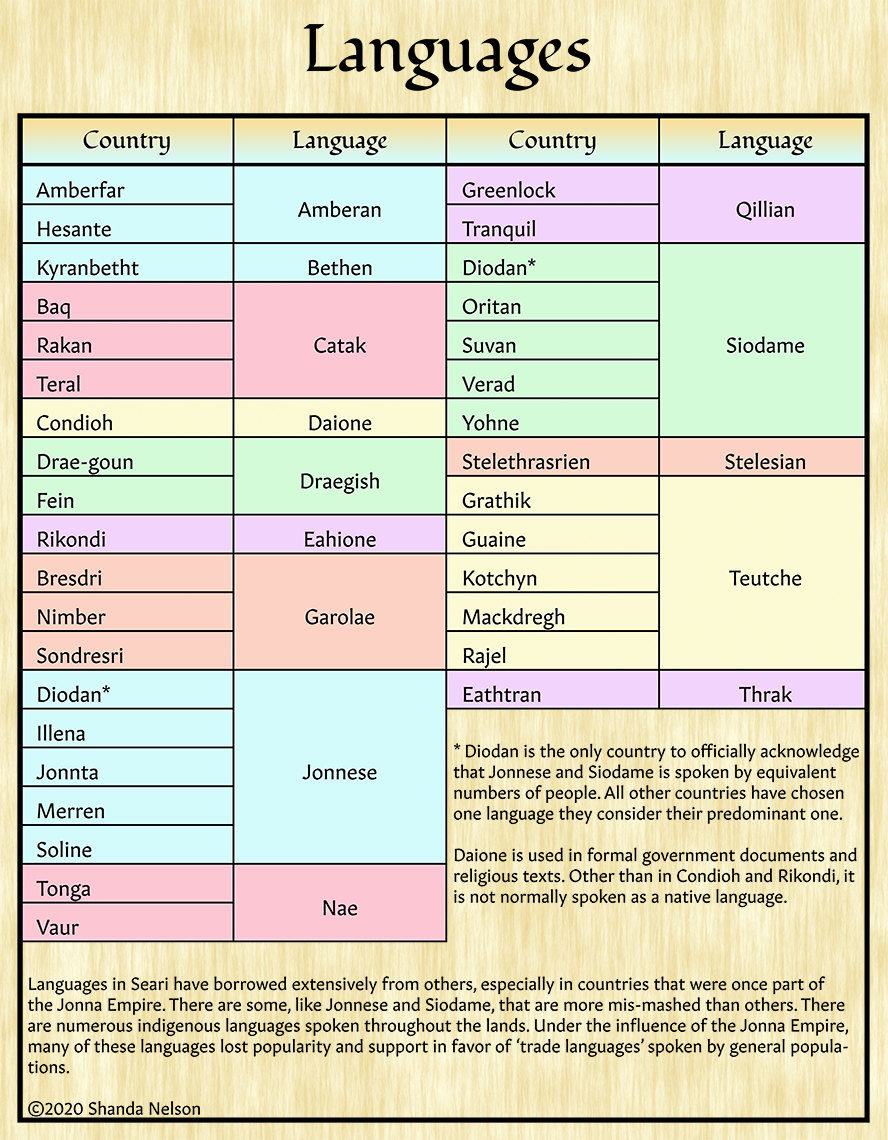Languages
Seari has a variety of languages. Many countries have several official languages, though one normally dominates the others. Lands once under the Jonna Empire banner have Daione as an official language, since older government documents and many religious texts are written in it. There are several indigenous languages only spoken by a few hundred or a few thousand people; most of these languages lost their native support during the Empire's push to whittle down communications to 'trade languages'. These trade languages tended to be spoken by regional majorities and favored by the ruling classes. The Empire claimed expediency in communication, but modern scholars believe they also knew important cultural ideas would die with native languages and Daione would fill the void. Many city dwellers know a second language, sometimes a third, and this is especially true in port cities. Rural inhabitants tend to speak one language and manage a few words in another. Rural border populations have a higher percentage of people who speak a second language, but they are normally involved with business or trade, and have little interest in learning vocabulary that expands beyond everyday uses. Language scholars are imporant members of intellectual circles and collaboratives. Linguistic genophytes from the Palace School in Iova are considered unrivaled language experts, and several provide governments and religious institutions with translations of older documents written in archaic forms. These genophytes tend to excel in historical scholarship, since they can read eyewitness and contemporary accounts without a mediary.Daione
Daione is the most influential Seari language. Not only is it a staple for religious texts, many governments of all sizes still use it to write important documents and laws. It influenced all other languages spoken by the peoples the Endion kings conquered, and some words and phrases filtered into non-empire tongues because it was so heavily used by traders and religious orders. Eahione shares 80% of its vocabulary with Daione, though oftentimes spelled differently. The grammar structures are the same. Both Daione and Eahione use the Goivahmarioh alphabet.
Catak
Catak had the most influence on Daione, likely because it was spoken by some of the first peoples the Jonna Empire conquered and encorporated into their army. It brought harder consonant sounds like -k and -t to a verb-heavy, softer consonant language. Catak uses the Ay a di alphabet.
Jonnese
Jonnese is natively spoken by the most people in Seari. Many traders will learn a few words to better communicate with buyers and sellers. While Jonnese is most often spoken in the Midem countries, ports have their share of people who speak it. Jonnese uses the Jonna alphabet.
Siodam
Siodame is the second-most spoken language in Seari, and has the most secondary speakers as well. It is closely related to Jonnese, but with more Daione influence. Most traders around and below the Sea of Condioh have a passing familiarity with it. Catak, Jonnese and Teutche speakers usually learn it as a second language due to its importance in trade. Siodame uses the Jonna alphabet.
Teutche
Teutche has a large western Seari population that speaks it. It spread through several countries through warlord invasions and subsequent refugee flight. Noble families in Merren speak it to honor their heritage. Teutche uses the Deushen alphabet.



Comments